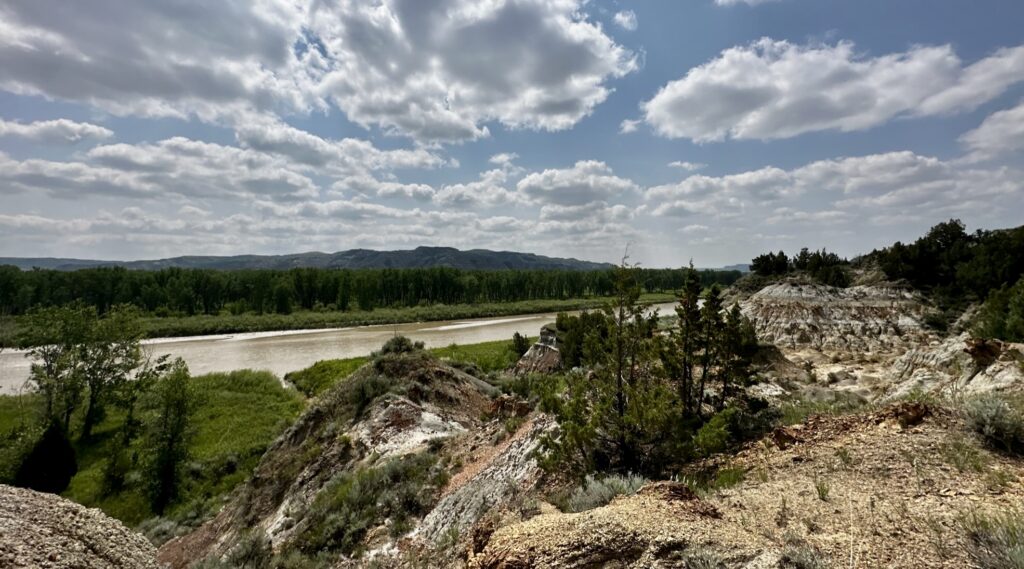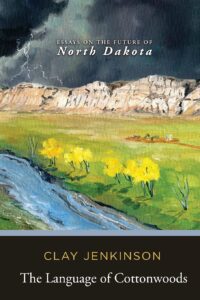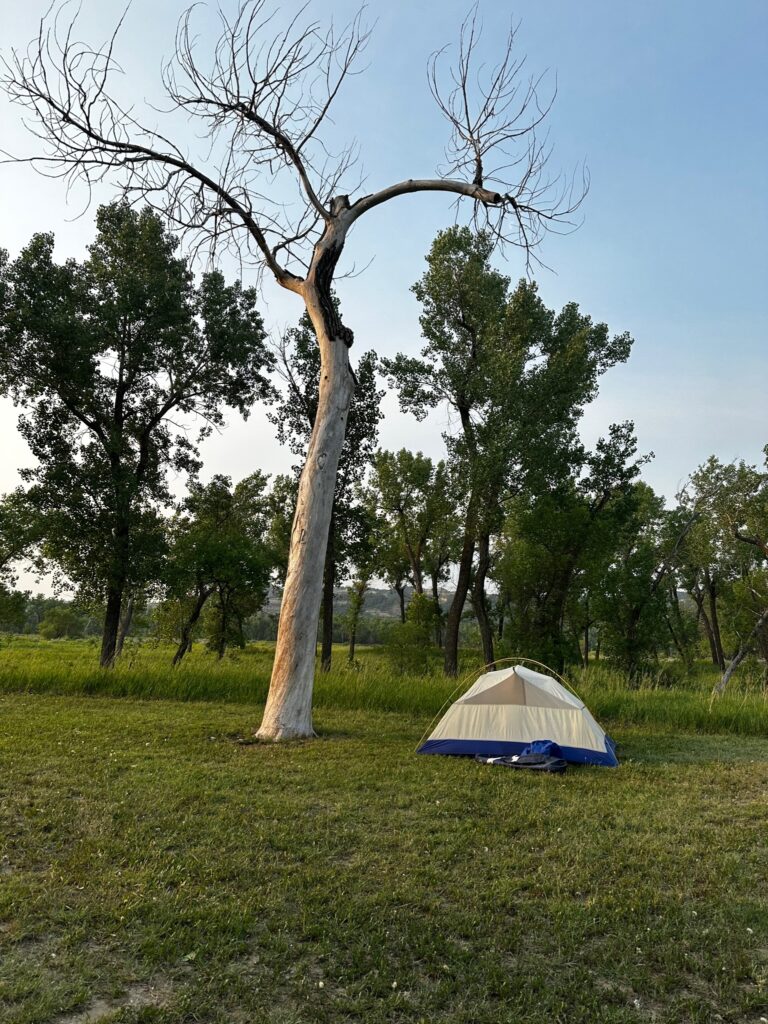
I co-led a hike in the North Unit of Theodore Roosevelt National Park recently. There were about a dozen of us. Our goal was a very old cottonwood tree in an obscure corner of the park down by the Little Missouri River. The tree is said to date to 1641. That’s the year the English Civil War began when King Charles I was forced to flee the throne. That’s just 20 years after the Pilgrims landed in Massachusetts. That’s a hundred years before Thomas Jefferson was born.
We drove to the rendezvous point in the North Unit near Watford City, N.D., from all directions. It was an outing of the Badlands Conservation Alliance. We had a group campsite to ourselves. The only problem with that is that the “comfort station” was lit up all night long and every time anybody went into either the women’s or men’s bathroom, loud bathroom fans started up for a full 30 minutes. It seems to me inexplicable that the National Park hasn’t devised a better technology than this, because to light it this way and make it emit gross industrial noise is to damage the National Park experience. We go to the parks to limit or eliminate our industrial advantage for a day or two or three. The parks should encourage solemnity and serenity and silence.
It was a perfect day. Temperature about 75, a light breeze. Dry. We drove to the put-in site and our participants geared up as if we were beginning an ascent of Kilimanjaro. You know: vests with 20 pockets; hiking sticks; double tying stiff hiking boots; Camelbacks and electrolytes and power bars; binoculars snugged up against the chest.
We took the wrong trail. As the Nixon boys put it, “mistakes were made.” This meant that for parts of our hike we were forced to bushwhack. There was plenty to trip over. We had to scramble a bit, keep our eyes alert for buffalo trails that might lead us down the bluffs in the gentlest possible way. Some people were getting a little frustrated, not sure they wanted to pursue this hike to wherever the dubious leaders were trying to take it. When we finally tumbled into the meadow next to the river, we were a little tired. About half of our group decided to hike out on the principle that when you’ve seen one ancient cottonwood you have seen them all.
Eventually, we remnants found the approximate location of the venerable tree, but it is not marked or identified, and — to be perfectly honest — there were half a dozen or more cottonwoods that deserve to be candidates for the title. Park officials are not that eager to direct people to the tree, lest some vandal burn or chop it down. So, we fanned out and took pictures and each group provided a wee report. I think Carl and I found the tree in question, but I wouldn’t swear on it. It was certainly the biggest in circumference. It was no less than a couple of hundred years old and it has had a very dramatic life. It looks as if it broke in half at some point and then new trunks sprang up from the tub of what was still anchored in the ground. It wasn’t carrying as many leaves as you would expect of a tree of that size, but it was still sending out thousands of leaves annually after 600 or more previous years of doing just that.

We took pictures. We formed a circle and held hands hugging the tree. My view was that we may as well prove our reputation, since in the heartland, in Red America, to be an active conservationist is to be a “damned environmentalist,” and a “tree hugger.” For me it is this simple. I love trees. I particularly love cottonwood trees. I believe trees have being. In fact, I believe they have a kind of consciousness. I believe trees can communicate, though not seemingly with humans. I don’t believe it does the tree much good when we hug it, but hugging it brings good to us as humans who constantly need to be reminded that it is not Us against the rest of creation. We are part of a larger creation. We have many siblings and cousins among other species. In other words, I think a tree is likely to do more good for me than I for it. And why should we lionize s/he who killed an elk, but ridicule him or her who embraced a tree? Thomas Jefferson told his friend Margaret Bayard Smith that he regarded any unnecessarily killing of a tree as a kind of murder.
Theodore Roosevelt loved the badlands. He played cowboy and rancher in Dakota Territory between 1883-1887. The cottonwood trees on the perimeter of his ranch house at the Elkhorn Ranch are still alive. Some of them at least. The house is long gone, but sandstone cornerstones articulate the perimeter. A mile or so north of his Elkhorn ranch house there is an isolated patch of very old cottonwoods — but their age is less than 200 years, surely. At no point did Roosevelt suggest that posterity create a national park in his honor. Or that the badlands should be protected by the U.S. government. Roosevelt saw the badlands as the last frontier. He reckoned that the cowboy era would yield to homesteaders and their barbed wire fences. He even thought that was the right evolution. It’s not clear what he would think of a national park named in his honor. For a man of heroic ego, he was surprisingly humble about the idea of monuments memorialized in his honor. Roosevelt had read enough history to know that oblivion swallows up 99.9999% of all human beings and leaves no historical trace.
Roosevelt might have ridden his favorite horse Manitou past the ancient tree in those badlands years. We were hiking about 20 miles downriver from his ranch. He’s not a regular noticer of cottonwoods in his badlands writings. If he knew for sure it was one of the oldest trees on the Great Plains, he would surely have paused to reflect.
But he would not have hugged a tree.
We camped two nights in Juniper Campground in the national park. The gin and tonic flowed. A man named Shannon grilled cheeseburgers and brats. His girlfriend Spring brought homemade potato salad and rhubarb dessert. We sipped wine until dark, which at this time of year in North Dakota is about 10:45 p.m. I lay in my sleeping bag flat on my back gazing up into the cosmos, and just listening to the nightlong rustle of the cottonwoods.
The Symphony of Cottonwoods

I have a special love affair with the cottonwood. If you’re interested, you’ll find my love song to the cottonwood in the last chapter of my book, The Language of Cottonwoods: Essays on the Future of North Dakota. Every year, without question, I get myself under a grove of old cottonwoods in late September when the leaves have turned. There is a magical mystical symphony that happens, with the metaphoric equivalent of “woodwinds,” “brass,” “strings,” etc. Different sections of the tree start to make sounds at different times. It’s as if the symphony conductor was nodding now at the violins and a couple of minutes later to the woodwinds. I can watch the dance of the cottonwood leaves for hours. The experience is heightened by the certainty that the first little warmup blizzard is no more than a month away, and probably much closer. You feel like you are living on borrowed time. The light has an autumnal melancholy to it.
This weekend cottonwoods were at their most lifebursting. They have plenty of water so far. There have been no ruinous thunderstorms yet. No periods of extreme heat. I must admit that I like them a bit more when they look a little “weathered,” a little beleaguered by the high windstorms of a North Dakota summer, and maybe a few weeks on short water rations. On the Little Missouri, which can run some respectable water every 10 or 15 years, you see not a continuous line of cottonwoods, but small groves of four to 12 trees along the bank of the river here, the bank of the river there, spaced apart by hundreds of yards, and often miles. When you get to one of those minimalist copses, you usually find that on two or three of the trees there are dead branches, even dead sections. That somehow speaks Great Plains, but it also speaks to the toughness of the cottonwood. It can stand a very large amount of abuse and still put forth leaves and new branches. I’ve seen an old tree 95% dead, shattered by lightning, maybe even fully bent over at the halfway mark; and yet from that part of the trunk that landed on the grass, the next year new shoots. To the point that I have seen some cottonwood trees that have come back from that catastrophe to send up a 45-foot resurrection.
In those little copses, I find a perfect place to camp for the night. Usually there is a dead cottonwood trunk on the ground, the bark entirely gone and thousands of tiny holes dug by whatever insects are repurposing all that biomass. You can sit on it or use it as a plate or a platform for a small gas stove. Or you can sit on the grass with your back against the trunk. If I were asked to define happiness, the campsite on the Little Missouri under tough old cottonwoods is certainly in my top five scenarios.

This weekend I pitched my Sierra Designs tent under a standing dead cottonwood in the group camping unit of the National Park. The price I paid for that was the industry of the red headed woodpecker late in the evening and first thing in the morning. My colleagues told me they had seen a big bull snake shinning up the bald trunk of the tree in search of woodpecker food. Still, I was close enough to the other 35 cottonwoods in the camping space or its immediate environs to be able to listen to them rustle and dance all night long. It was a deeply agreeable sound, and every five minutes or so the breeze would get strong enough to billow my tent a little and lave me with sweet slightly chilled air.
I use the word “lave,” but I am not happy with it. How do you describe that moment when the breeze suddenly comes, but gently, and it flows almost lovingly across your face? I think of the word “caress,” almost “kiss” or “feather.” “Lave” seems to come closest. It comes from a Latin word meaning wash, but today’s meaning is on the light gentle side of the idea of washing. Like using the tip of a washcloth to wipe away tears in a crying child.
It was a splendid weekend. I had hoped to do more field work for the book I am writing about the history of Theodore Roosevelt National Park. What I chiefly learned was that the trail we used to come up from the ancient tree is one of the best designed National Park trails I have ever been on. It distributes the vertical climb perfectly. At no point do you feel compelled to stop. You do stop four or five times to breathe and rest, but you would not have to if you were in any kind of hurry. Once you climb out of the canyon, the trail threads its way through a 1.5 mile plain of grass to the parking lot. In a single hike you get equal measures of the badlands and the plains.
When I get home from one of these excursions, I keep my Yeti iced up in the back seat of my Honda for a couple of days, and I get my cold water and soda out of the Yeti. This really makes no sense, but it pleases me. It makes the adventure linger a little. The soda is colder than it would be out of the refrigerator. I feel I get a little extra camp time before the world sucks me back in.
